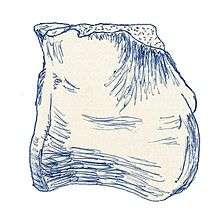Dryptosauroides
| Dryptosauroides Temporal range: Late Cretaceous, 66 Ma | |
|---|---|
 | |
| Vertebra | |
| Scientific classification | |
| Kingdom: | Animalia |
| Phylum: | Chordata |
| Class: | Sauropsida |
| Superorder: | Dinosauria |
| Order: | Saurischia |
| Suborder: | Theropoda |
| Infraorder: | Ceratosauria |
| Superfamily: | Abelisauroidea |
| Family: | Abelisauridae |
| Genus: | Dryptosauroides Huene & Matley, 1933 |
| Species | |
| |
Dryptosauroides (meaning "similar in form to Dryptosaurus") is the name given to a genus of dinosaur from the Late Cretaceous. It was a large theropod, possibly belonging to the Abelisauridae.
Its fossils, consisting of six caudal vertebrae, together forming type specimens GSI IM K20/334, 609, K27/549, 601, 602 and 626, were found in India in the Lameta Formation of the Maastrichtian. The vertebrae, originally incorrectly identified as dorsals, are thirteen to fourteen centimetres long. These remains are today commonly considered to be indistinguishable from those of other theropods from the same formation. As a result, Dryptosauroides is seen as a nomen dubium.
The type species, Dryptosauroides grandis, was named by Friedrich von Huene in 1932 and described by him and Charles Alfred Matley in 1933. The specific name grandis means "large" in Latin.
See also
References
- Huene, F. von, 1932, Die fossile Reptil-Ordnung Saurischia: ihre Entwicklung und Geschichte. Monographie für Geologie und Palaeontologie, Parts I and II, ser. I, 4:1-361
- Huene, F. von, and Matley, C. A. (1933) "The Cretaceous Saurischia and Ornithischia of the central provinces of India" Memoirs of the Geological Survey of India 21: 1-74